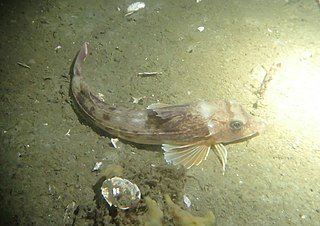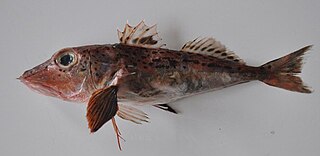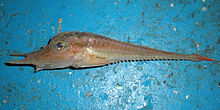
Triglidae, commonly known as gurnards or sea robins, are a family of bottom-feeding scorpaeniform ray-finned fish. The gurnards are distributed in temperate and tropical seas worldwide.

Peristediidae, the armored sea robins or armoured gurnards, is a family of ray-finned fishes belonging to the suborder Platycephaloidei in the order Scorpaeniformes. They are found in the deep water in the tropical and warm temperate of the world's oceans.

The tub gurnard, also known as the sapphirine gurnard, tube-fish, tubfish or yellow gurnard, is a species of marine ray-finned fish belonging to the family Triglidae, the gurnards and sea robins. It is found in the eastern Atlantic Ocean. It is exploited by commercial fisheries as a food fish.

Chelidonichthys, the smallscaled gurnards, is a genus of marine ray-finned fishes belonging to the family Triglidae, the gurnards and sea robins. These gurnards are found in the Eastern Atlantic, Indian and Western Pacific Oceans.

The spiny red gurnard is a species of marine ray-finned fish belonging to the family Triglidae, the gurnards and sea robins. This species is found in the northwestern Pacific Ocean where they occur at depths of from 25 to 615 metres. This species grows to a length of 40 centimetres (16 in) TL. This species is of commercial importance as a food fish.

The grey gurnard is a species of ray-finned fish from the family Triglidae, the gurnards and sea robins. It is native to the eastern Atlantic Ocean, the Mediterranean Sea, and the Black Sea. It is caught as a food fish and is known for producing sounds. It is the only member of the monotypic genus Eutrigla.

Lepidotrigla is a genus of marine ray-finned fishes belonging to the family Triglidae, the gurnards and sea robins. These gurnards are found in the Eastern Atlantic, Indian and Western Pacific Oceans.

The piper gurnard, also known as the piper or the lyre gurnard, is a species of marine, demersal ray-finned fish from the family Triglidae, the gurnards and sea robins. It is found in the eastern Atlantic Ocean and the Mediterranean Sea. It is the only species in the monotypic genus Trigla.

The red gurnard, also known as the East Atlantic red gurnard or soldier, is a benthic species of ray-finned fish belonging to the family Triglidae, the gurnards and sea robins. This fish is found in the eastern Atlantic Ocean, including the Mediterranean Sea and the Black Sea.

The jaggedhead gurnard is a species of marine ray-finned fish belonging to the family Peristediidae, the armoured gurnards or armored searobins. This species is found in the eastern Indian Ocean and the western Pacific Ocean. It is the only known member of its genus.
Heminodus is a genus of marine ray-finned fish belonging to the family Peristediidae, the armoured gurnards or armored sea robins. It is currently considered to be a monotypic genus, its only species being Heminodus philippinus.
Paraheminodus is a genus of marine ray-finned fish belonging to the family Peristediidae, the armoured gurnards or armored searobins. These fishes are found in the western Pacific Ocean.

Peristedion is a genus of marine ray-finned fish belonging to the family Peristediidae, the armoured gurnards or armored sea robins. These fishes are found in Atlantic and Indo-West Pacific ocean waters.

The streaked gurnard, also known as the African gurnard or rock gurnard, is a species of ray-finned fish belonging to the family Triglidae, the gurnards and sea robins. This fish is found in the eastern Atlantic Ocean and western Indian Ocean. This species is of commercial importance as a food fish.
The longfin gurnard, the long-finned gurnard or shining gurnard, is a species of ray-finned fish belonging to the family Triglidae, the gurnards and sea robins. This fish is found in the eastern Atlantic Ocean, including the Mediterranean Sea and the Black Sea. This species is of commercial importance as a food fish.

Peristedion greyae, the alligator searobin, alligator armored searobin or prickly armoured sea robin, is a species of marine ray-finned fish belonging to the family Peristediidae, the armoured gurnards or armored sea robins. It is found in the western central Atlantic.
Pterygotrigla multiocellata, the antrorse spined gurnard, is a species of ray-finned fish belonging to the family Triglidae, the gurnards and sea robins. This fish is found in the Indo-Pacific region where it has been recorded from Japan, Saipan, and the eastern and western tropical waters off Australia.

Pterygotrigla polyommata, the latchet, butterfly gurnard, flying gurnard, lachet gurnard, pastry, sharpbeak gurnard, spiny gurnard or spinybeak gurnard, is a species of marine ray-finned fish belonging to the family Triglidae, the gurnards and sea robins. It is found in the southeastern Indian and southwestern Pacific Oceans.

The blackspotted gurnard, also known as the half-spotted gurnard, is a species of marine ray-finned fish belonging to the family Triglidae, the gurnards and sea robins. It is found in the Indo-Pacific region.

The large-scaled gurnard is a species of marine, demersal ray-finned fish from the family Triglidae, the gurnards and sea robins. It is found in the eastern Atlantic Ocean and the Mediterranean Sea.
















